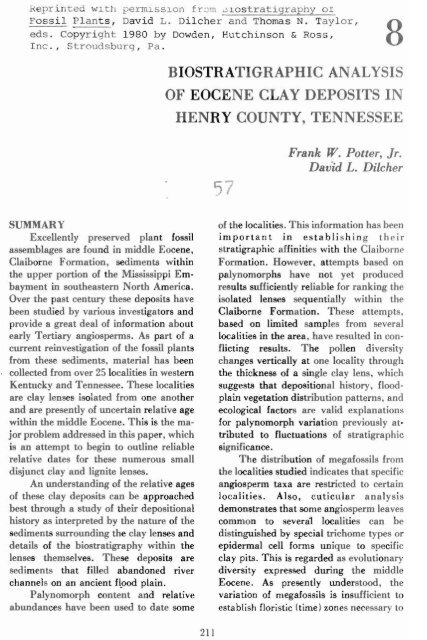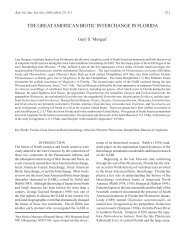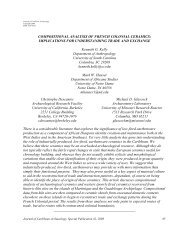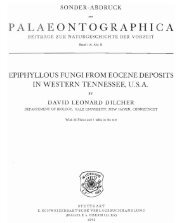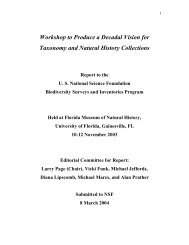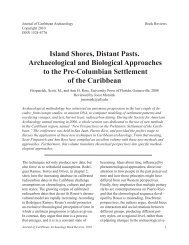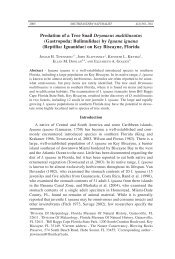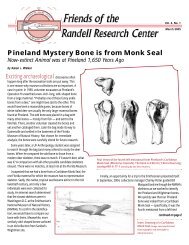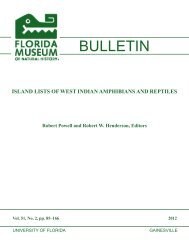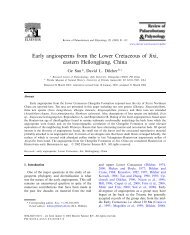biostratigraphic analysis of eocene clay deposits in henry county ...
biostratigraphic analysis of eocene clay deposits in henry county ...
biostratigraphic analysis of eocene clay deposits in henry county ...
You also want an ePaper? Increase the reach of your titles
YUMPU automatically turns print PDFs into web optimized ePapers that Google loves.
<strong>in</strong>terpret the history <strong>of</strong> the deposition <strong>of</strong><br />
lh('s(' <strong>clay</strong> lens('s. However. the<br />
nwgafossils comb<strong>in</strong>f>d with othf>r floristic<br />
rea turt's and sedimentary features provide<br />
data that can be applied to the history <strong>of</strong><br />
deposition <strong>of</strong> the <strong>clay</strong> lens under consideration.<br />
We suggest a model for this<br />
deposition here.<br />
The depositional model presented is<br />
based primarily upon the vertical relation<br />
<strong>of</strong> the <strong>clay</strong> lenses to one another. It also<br />
provides an explanation for the vertical<br />
variation observed <strong>in</strong> the pollen pr<strong>of</strong>iles <strong>of</strong><br />
these <strong>clay</strong> lenses. There are some changes<br />
<strong>in</strong> floristic composition, leaf morphology,<br />
and cuticular anatomy observed between<br />
<strong>deposits</strong>. Also the depositional history <strong>of</strong><br />
each <strong>clay</strong> lens can be traced through<br />
phases, which resulted <strong>in</strong> similar sedimentary<br />
sequences or parts <strong>of</strong> sequences for<br />
most <strong>clay</strong> lenses studied. Support for this<br />
model <strong>of</strong> the ancient flood-pla<strong>in</strong> sediments<br />
<strong>in</strong> western Tennessee is also provided by<br />
evolutionary trends <strong>of</strong> select leaf types.<br />
INTRODUCTION<br />
Clay lenses are commonly distributed<br />
along the sedimentary beds <strong>of</strong> the<br />
Mississippi Embayment that are exposed<br />
<strong>in</strong> a narrow zone runn<strong>in</strong>g northeast by<br />
southwest through western Kentucky and<br />
Tennessee. The age <strong>of</strong> these sediments<br />
ranges from Upper Cretaceous to middle<br />
Eocene. Follow<strong>in</strong>g the Embayment axis<br />
(northeast-southwestf the Cretaceous<br />
sediments are exposed along the extreme<br />
eastern marg<strong>in</strong> <strong>of</strong> this zone and the<br />
youngest sediments lie to the west. This<br />
report is concerned with those <strong>clay</strong> lenses<br />
<strong>in</strong> western Kentucky and Tennessee which<br />
are considered to be part <strong>of</strong> the Claiborne<br />
Formation deposited dur<strong>in</strong>g the middle<br />
Eocene (Figure 8.l1.<br />
We have exam<strong>in</strong>ed the sediments<br />
from numerous <strong>clay</strong> pill; <strong>in</strong> the area shown<br />
<strong>in</strong> Figure 8.2. Nearly 2S <strong>clay</strong> pits have<br />
yielded fossil leaves, fruits, seeds, wood,<br />
flowers. and pollen. Each <strong>clay</strong> body<br />
212<br />
represents an isolated depositional event<br />
<strong>in</strong> space; and the question to be addressed<br />
is, do these <strong>clay</strong> <strong>deposits</strong> also represent<br />
isolated events <strong>in</strong> time? And, if these<br />
depositional events do represent limited<br />
and different segments <strong>of</strong> middle Eocene<br />
time, can some orderly arrangement <strong>of</strong><br />
their sequence <strong>of</strong> deposition be<br />
discovered? This paper is an attempt to<br />
arrange these <strong>clay</strong> pits <strong>in</strong> a stratigraphic<br />
sequence. The evidence available is the<br />
preserved palynomorphs, megafossil<br />
material, and the geomorphology <strong>of</strong> the<br />
<strong>clay</strong> bodies. The work presented here is an<br />
attempt to establish a prelim<strong>in</strong>ary sequence<br />
as a work<strong>in</strong>g model to be ref<strong>in</strong>ed<br />
and affirmed or corrected by further and<br />
more detailed study. The importance <strong>of</strong><br />
establish<strong>in</strong>g such a sequence is that it<br />
allows the use <strong>of</strong> the Mississippi Embayment<br />
sediments as a <strong>biostratigraphic</strong> tool<br />
to f<strong>in</strong>ely divide and sort out <strong>in</strong><br />
chronological order vegetational changes<br />
<strong>of</strong> plant ecosystems and evolutionary<br />
modifications <strong>of</strong> plant fonn <strong>in</strong> the structurally<br />
preserved fruits, seeds, leaves,<br />
flowers, and wood common <strong>in</strong> these<br />
sediments.<br />
Many leaves, fruits, seeds, and<br />
flowers are restricted to particular <strong>clay</strong><br />
pits; a few fossil forms are common to<br />
nearly all pits. Palynomorphs, as well,<br />
may be restricted to particular <strong>clay</strong> pits or<br />
even to particular zones with<strong>in</strong> a <strong>clay</strong> pit<br />
(Potter, 1976). A careful comparative<br />
study <strong>of</strong> the pollen types <strong>of</strong> various <strong>clay</strong><br />
pits has not been done, but it would yield a<br />
great deal <strong>of</strong> useful data. Isolated pollen<br />
samples have been analyzed and<br />
numerous megafossils have been collected<br />
from these <strong>clay</strong> pits. The data available<br />
from these studies are used <strong>in</strong> this report.<br />
Recent pollen studies <strong>of</strong> the<br />
Mississippi Embayment region have been<br />
summarized by Elsik (1974); Elsik and<br />
Dilcher, (19741. Fairchild and Elsik<br />
(19691, Frederickson. (19691, Potter<br />
(19761 and Tschudy (l973a, b, 19751.
These <strong>in</strong>vestigators recognize the<br />
usefulness and importance <strong>of</strong> the pollen<br />
pr<strong>of</strong>iles <strong>of</strong> these isolated <strong>clay</strong> <strong>deposits</strong> and<br />
some establish particular zones based on<br />
the presence or absence and the abundance<br />
<strong>of</strong> various pollen types. Basic pollen<br />
types have been recognized for the Eocene<br />
sediments <strong>of</strong> the embayment area and<br />
Fairchild and Eisik (1969); Tschudy<br />
0973bi: and Elsik (974). present <strong>in</strong>dex<br />
palynomorphs for the Gull Coast (based<br />
on presence or absence and abundance <strong>of</strong><br />
pollen types) that allow an <strong>in</strong>vestigator to<br />
discrim<strong>in</strong>ate among lower, middle, and<br />
upper Eocene sediments. Tschudy charts<br />
the occurrences f the palynomorphs <strong>in</strong><br />
the Mississippi Embayment <strong>in</strong>dicat<strong>in</strong>g<br />
limited stratigraphic ranges <strong>of</strong> several<br />
with<strong>in</strong> the middle Eocene; Elsik also plots<br />
relative abundances <strong>of</strong> palynomorphs for<br />
the Claiborne sediments <strong>of</strong> the Texas Gulf<br />
Coast. These ata suggest that<br />
palynomorphs can be used to place these<br />
isolated <strong>clay</strong> lenses <strong>in</strong> the Wilcox,<br />
Claiborne, or Jackson (lower, middle, upper<br />
Eocene) formations and possibly also<br />
provide precise <strong>in</strong>formation as to subdivision<br />
<strong>of</strong> member age equivalent for middle<br />
Eocene time.<br />
The ability to subdivide Claiborne<br />
time us<strong>in</strong>g palynomorphs (Tschudy.<br />
1973b gave some hope that each <strong>of</strong> the<br />
numerous isolated <strong>clay</strong> lenses <strong>in</strong> estern<br />
Tennessee and Kentucky could be placed<br />
stratigraphically if pollen samples were<br />
analyzed. Before such a general project <strong>of</strong><br />
sampl<strong>in</strong>g was undertaken. however, we<br />
felt that it was critical to exam<strong>in</strong>e the<br />
nature <strong>of</strong> a s<strong>in</strong>gle <strong>clay</strong> lens <strong>in</strong> some detail.<br />
Therefore, the palynomorphs <strong>of</strong> the Miller<br />
<strong>clay</strong> pit were exam<strong>in</strong>ed from precisely<br />
located samples lvertically at 10-cm <strong>in</strong>tervals)<br />
from the base up to the top <strong>of</strong> a<br />
lOom-thick seam <strong>of</strong> <strong>clay</strong>-lignite-<strong>clay</strong><br />
exposed <strong>in</strong> open pit m<strong>in</strong><strong>in</strong>g. As a result <strong>of</strong><br />
this work. Potter (1976) found that the<br />
relative abundance <strong>of</strong> pollen types present<br />
varied as the lithology <strong>of</strong> the sediments<br />
214<br />
varied, <strong>in</strong>dicat<strong>in</strong>g a strong environmental<br />
control <strong>in</strong>fluenc<strong>in</strong>g this aspect <strong>of</strong> the<br />
pollen pr<strong>of</strong>ile. Potter questioned the<br />
stratigraphic usefulness <strong>of</strong> the abundance<br />
<strong>of</strong> palynomorphs and <strong>in</strong>dicated that some<br />
pollen types may be more important as environmental<br />
<strong>in</strong>dicators than as <strong>in</strong>dicators<br />
<strong>of</strong> the subdivision <strong>of</strong> Claiborne time.<br />
Detailed pollen pr<strong>of</strong>iles <strong>of</strong> several <strong>clay</strong> pits<br />
open <strong>in</strong> this area should be completed.<br />
Such studies will provide important data<br />
to test the model proposed here <strong>of</strong> the<br />
depositional history <strong>of</strong> these lenses.<br />
Early paleobotanical report<strong>in</strong>g was<br />
done by Berry (1916, 1930 Ion the floras <strong>of</strong><br />
over 200 Pal ogene plant-bear<strong>in</strong>g<br />
localities (many <strong>of</strong> which were from <strong>clay</strong><br />
<strong>deposits</strong>) <strong>in</strong> southeastern North America.<br />
He suggested a paleoenvironment for<br />
deposition <strong>of</strong> such plant-bear<strong>in</strong>g<br />
sediments generalized from a locality he<br />
exam<strong>in</strong>ed <strong>in</strong> Texas. He concluded that<br />
these <strong>clay</strong> <strong>deposits</strong> represent near-mar<strong>in</strong>e<br />
paleoenvironments with strand vegetation<br />
while some others represent drowned river<br />
valleys Berry (1916, 1930).<br />
Dilcher (1971) considered the orig<strong>in</strong><br />
<strong>of</strong> the <strong>clay</strong> lenses only <strong>in</strong> western Kentucky<br />
and Tennessee. The <strong>in</strong>formation applied<br />
to this question was derived from<br />
outl<strong>in</strong>e maps <strong>of</strong> known <strong>clay</strong> <strong>deposits</strong>, the<br />
form <strong>of</strong> their cross-section, and the<br />
nature <strong>of</strong> sediments underly<strong>in</strong>g the <strong>clay</strong>s.<br />
Potter (19761, concentrat<strong>in</strong>g upon a s<strong>in</strong>gle<br />
<strong>clay</strong> lens, carried this <strong>analysis</strong> further.<br />
The results <strong>of</strong> these studies demonstrate<br />
that the small <strong>clay</strong> lenses typica <strong>of</strong> Henry<br />
County, Tennessee, and nearby areas are<br />
narrow, L<strong>in</strong>ear-elongated, most <strong>of</strong>ten<br />
curved, river-channel shaped <strong>in</strong><br />
cross-section, surrounded on the sides<br />
and undersides by cross-bedded sands<br />
(occasionally f<strong>in</strong>e gravels), and consist <strong>of</strong><br />
uniform f<strong>in</strong>e <strong>clay</strong>s with an occasional<br />
Lignitic seam or cap. Primarily upon this<br />
<strong>in</strong>formation, we proposed that these<br />
smaU,curved, elongated <strong>clay</strong> lenses represent<br />
<strong>clay</strong> plugs <strong>in</strong> oxbow lakes on an an
personal communication 1 an upper<br />
Claiborne (Cockfield Fm., and perhaps<br />
Cook Mt. Fm. or lower Cockfield Fm.1<br />
age for them.<br />
Local<br />
The mar<strong>in</strong>e transgressions <strong>of</strong> the<br />
Eocene (Figure 8.3l can not be identified<br />
<strong>in</strong> the Henry County area <strong>of</strong> western Tennessee<br />
(Parks, 19711. The more extensive<br />
transgressions such as those separat<strong>in</strong>g the<br />
Wilcox, Claiborne, and Jackson groups<br />
can be identified only <strong>in</strong> the southwestern<br />
corner <strong>of</strong> Tennessee (Stearns, 1957; Murray,<br />
19611. The Claiborne Formation <strong>in</strong><br />
Henry County, Tennessee, consists ma<strong>in</strong>ly<br />
<strong>of</strong> non-mar<strong>in</strong>e sands and isolated disjunct<br />
lenses <strong>of</strong> <strong>clay</strong>. As already discussed,<br />
there are numerous plant fossil-bear<strong>in</strong>g<br />
lenses <strong>of</strong> <strong>clay</strong> <strong>in</strong> this area. Data from a<br />
regional consideration <strong>of</strong> the pollen flora,<br />
where it can be tied <strong>in</strong>to mar<strong>in</strong>e sequences.<br />
<strong>in</strong>dicates that these lenses are<br />
best considered to be late-middle Eocene<br />
<strong>in</strong> age ICockfield Formation <strong>of</strong> the<br />
Claiborne Group) \Elsik. ]974; Elsik and<br />
Dilcher. 1974; Tschudy, personal communicationl.<br />
Differences <strong>in</strong> the floras <strong>of</strong><br />
particular <strong>clay</strong> pits <strong>in</strong> Henry County, Tenn<br />
.ssee. ano near-by areas are obvious by<br />
a comparison <strong>of</strong> the composition <strong>of</strong> the<br />
floras from each pit and by the specific<br />
nature <strong>of</strong> the epidermal cells, trichomes,<br />
and aspects <strong>of</strong> the overall leaf form <strong>of</strong><br />
several taxa. Two explanations for these<br />
differences are: ecological variability or<br />
evolutionary variability. It is important to<br />
attempt to reconstruct the paleoenvironments<br />
and relative ages <strong>of</strong> these <strong>clay</strong><br />
pits <strong>in</strong> order to understand the cause <strong>of</strong> the<br />
variations observed <strong>in</strong> the fossil record<br />
between these sites.<br />
The ecology <strong>of</strong> most <strong>deposits</strong> seems to<br />
have repeated a relatively similar history<br />
for each <strong>clay</strong> lens. As discussed earlier <strong>in</strong><br />
this paper and by Dilcher (19711 and Potter<br />
(1976), the nature <strong>of</strong> these sediments<br />
<strong>in</strong>dicates a typical oxbow-lake cleposi<br />
21/<br />
tional system. Each <strong>clay</strong> lens repeats a<br />
similar environmental history with some<br />
variation <strong>in</strong> the extent <strong>of</strong> associated lignite<br />
and relative abundance <strong>of</strong> plant fos"ik<br />
Thus environmental factors most probably<br />
do not account for the differences<br />
observed <strong>in</strong> the plant fossils from <strong>clay</strong> pit<br />
to <strong>clay</strong> pit.<br />
The most logical explanation for the<br />
observed differences <strong>of</strong> the types, relative<br />
abundance, form, and anatomy <strong>of</strong> the<br />
plants at the various localities is that each<br />
locality represents a slightly dilferent segment<br />
<strong>of</strong> time. The time <strong>in</strong>terval <strong>of</strong> evolu<br />
,ion preserved <strong>in</strong> each <strong>clay</strong> pit is very short<br />
1500 to 1500 yearsl because oxbow lakes<br />
on a flood pla<strong>in</strong> are recognized as shortterm<br />
events when viewed aga<strong>in</strong>st<br />
geological time (Crisman and Whitehead,<br />
1975). The tools available at the present,<br />
such as palynology and knowledge <strong>of</strong> the<br />
megafossils are probably not sufficient to<br />
rank order these <strong>in</strong>dividual <strong>clay</strong> pits<br />
with<strong>in</strong> Cockfield Formation time. The<br />
data provided below is presented <strong>in</strong> an attempt<br />
to establish a rank order for these<br />
<strong>clay</strong> pits with<strong>in</strong> late-middle Eocene time.<br />
DEPOSITION OF FOSSIL·<br />
BEARING SEDIMENTS<br />
The low-ly<strong>in</strong>g features <strong>of</strong> the<br />
Mississippi Embayment allowed for easy<br />
migration <strong>of</strong> river s}'stems across broad<br />
flood pla<strong>in</strong>s; as sediments brought <strong>in</strong> by<br />
the rivers accumulated. Deposition <strong>of</strong> lhe<br />
flood-pla<strong>in</strong> sediments. discussed <strong>in</strong> lhis<br />
paper. resulted from the meander<strong>in</strong>g <strong>of</strong><br />
the"Appalachian" River system enter<strong>in</strong>g<br />
the embayment <strong>in</strong> Kentucky and build<strong>in</strong>g<br />
a poorly def<strong>in</strong>ed delta <strong>in</strong> North Central<br />
Mississippi (Grim, 19361.<br />
Based upon field exam<strong>in</strong>ation; the<br />
<strong>clay</strong> pits can be differentiated <strong>in</strong>to two<br />
types. One lype ha!l relatively massive<br />
<strong>deposits</strong> <strong>of</strong> <strong>clay</strong> and some associated<br />
lignites. Often these lignite seams overlie<br />
the <strong>clay</strong>s, although <strong>in</strong> some localities the<br />
lignite is <strong>in</strong>terspersed with the <strong>clay</strong>s. No
good megafossils have been found <strong>in</strong> these<br />
<strong>clay</strong>s. The lignites arc sufficiently decomposed<br />
to obscure plant structure and <strong>in</strong><br />
some localities numerous root channels extend<br />
from the lignite <strong>in</strong>to the underly<strong>in</strong>g<br />
<strong>clay</strong>. These features suggest a low-ly<strong>in</strong>g<br />
area <strong>of</strong> shallow water receiv<strong>in</strong>g f<strong>in</strong>e-gra<strong>in</strong><br />
sediments <strong>in</strong>terspersed with some swamp<br />
environments with accumulation <strong>of</strong><br />
organic material.<br />
The second type <strong>of</strong> <strong>clay</strong> pit consists <strong>of</strong><br />
small isolated <strong>clay</strong> lenses, <strong>of</strong>ten accompanied<br />
by overly<strong>in</strong>g lignite seams.<br />
Generally, these lenses have 5 to 10 m <strong>of</strong><br />
light tan <strong>clay</strong> lack<strong>in</strong>g micro-and<br />
megafossils, overla<strong>in</strong> by dark brown to<br />
gray <strong>clay</strong> rich <strong>in</strong> plant fossils. The overly<strong>in</strong>g<br />
lignites consist <strong>of</strong> compacted "leaves,<br />
wood, fruits, and seeds; and occasionally<br />
above the lignites are scattered layers <strong>of</strong><br />
light tan, gray, to p<strong>in</strong>k <strong>clay</strong>s or sands. The<br />
<strong>clay</strong> <strong>deposits</strong> are underla<strong>in</strong> by crossbedded<br />
channel sands (as seen at the<br />
Puryear site) and unsorted pea-size<br />
stream gravels (the Warman sitel; and, <strong>in</strong><br />
outl<strong>in</strong>e and cross-section. they are<br />
characteristic <strong>of</strong> abandoned channels apparently<br />
represent<strong>in</strong>g meander cut<strong>of</strong>f<br />
sloughs, oxbow lakes, and stream reaches<br />
(Figure 8.41. Field exam<strong>in</strong>ation <strong>in</strong>dicates<br />
a common depositional history for most <strong>of</strong><br />
the lenses <strong>of</strong> <strong>clay</strong>. The fossil-bear<strong>in</strong>g <strong>clay</strong>s<br />
are a product <strong>of</strong> f<strong>in</strong>e sediments, which filled<br />
the oxbow lakes on the ancient flood<br />
pla<strong>in</strong>. The lignites accumulated as the<br />
lake was filled with <strong>clay</strong>, form<strong>in</strong>g a wet<br />
swampy environment. These events probably<br />
took about 500 to 1500 years.<br />
Several <strong>clay</strong> lenses conta<strong>in</strong> fossil<br />
assemblages represent<strong>in</strong>g both <strong>of</strong> the<br />
above paleoenvironments, some lack any<br />
evidence <strong>of</strong> lignite accumulation, but all<br />
represent short <strong>in</strong>dividual segments <strong>of</strong><br />
time.<br />
Sufficient sites are present <strong>in</strong> western<br />
Tennessee to permit comparison <strong>of</strong> vertical<br />
position as determ<strong>in</strong>ed from<br />
topographic maps and overburden ex<br />
218<br />
posures observed <strong>in</strong> the field (Figure 8.41.<br />
Although not all sites align precisely, an<br />
<strong>in</strong>itial eastward meander<strong>in</strong>g-channel<br />
shift is suggested. Once reach<strong>in</strong>g the<br />
eastern marg<strong>in</strong> <strong>of</strong> the embayment. cont<strong>in</strong>ued<br />
deposition shifted the channel back<br />
toward the bas<strong>in</strong> axis. This resulted <strong>in</strong> a<br />
sequence <strong>of</strong> channel <strong>deposits</strong> ascend<strong>in</strong>g <strong>in</strong><br />
age, oldest near the base <strong>of</strong> the series along<br />
the west edge <strong>of</strong> the study area, the<br />
youngest also at the western edge but at a<br />
higher elevation (Figure 8.51. The eastern<br />
pits. e.g., Puryear, are <strong>of</strong> <strong>in</strong>termediate<br />
age. Thus the sequenc<strong>in</strong>g <strong>of</strong> the relative<br />
ages <strong>of</strong> the pits is based upon their relative<br />
geomorphic position <strong>in</strong> the flood pla<strong>in</strong>.<br />
The whole series <strong>of</strong> <strong>clay</strong> lenses represents a<br />
geologically short time span, the last<br />
sweep <strong>of</strong> the river hav<strong>in</strong>g occurred dur<strong>in</strong>g<br />
late-middle Eocene (Claiborne Group)<br />
deposition.<br />
The lithology <strong>of</strong> the two pit types provides<br />
support<strong>in</strong>g evidence, the basal <strong>clay</strong><br />
and lignite sites are believed to represent<br />
an almost flat lowland-swamp<br />
flood-pla<strong>in</strong> environment slop<strong>in</strong>g approximately<br />
three feet per mile southward<br />
(Figure 8.6a), These lowland, swampy<br />
areas were dissected and buried by the<br />
sediments <strong>of</strong> the shift<strong>in</strong>g river system that<br />
produced the ascend<strong>in</strong>g series <strong>of</strong> <strong>clay</strong><br />
plugs (Figure 8.6bl. The amount <strong>of</strong> silt<br />
and <strong>clay</strong> accumulation and organic content<br />
<strong>of</strong> these plugs depended on the<br />
degrees <strong>of</strong> isolation from the ma<strong>in</strong> channel<br />
as the river returned to its orig<strong>in</strong>al course<br />
(Figure 8.6c).<br />
This model provides a straightforward<br />
explanation for the data presently<br />
available regard<strong>in</strong>g the nature <strong>of</strong> the fossil<br />
plant record and sedimentology <strong>of</strong> these<br />
<strong>clay</strong> lenses. The fossil assemblages can be<br />
exam<strong>in</strong>ed for evolutionary changes and<br />
environmental <strong>in</strong>fluences <strong>in</strong>dependently <strong>of</strong><br />
their use to establish the time controls.<br />
Selected megafossil distribution<br />
among the <strong>clay</strong> <strong>deposits</strong> is presented <strong>in</strong><br />
Figure 8.7. This figure is presented to
--------<br />
FIGURE 8.6 Meander sweep <strong>of</strong> the Appalachian River system dur<strong>in</strong>g Late-Middle<br />
Claiborne time. a, <strong>in</strong>itial position; b, eastern extent <strong>of</strong> migration; c, end <strong>of</strong> migration cycle.<br />
22J
show that more data than is presently<br />
available is required <strong>in</strong> order to use<br />
megafossils as reliable <strong>in</strong>dicators for arrang<strong>in</strong>g<br />
these <strong>clay</strong> <strong>deposits</strong> <strong>in</strong> an ordered<br />
sequence. Much more work is needed to<br />
sort out ecological versus stratigraphical<br />
control over the occurence <strong>of</strong> megafossils.<br />
To relate the <strong>clay</strong>s to the regional<br />
stratigraphy <strong>of</strong> the embayment, the most<br />
reliable and useful fossil material <strong>in</strong> these<br />
terrestrial <strong>clay</strong> <strong>deposits</strong> is pollen. The<br />
megafossil material reflects local paleoenvironments.<br />
The variability observed <strong>in</strong><br />
angiosperm leaf cuticles provides<br />
recognizable differences between elements<br />
<strong>of</strong> the floras that otherwise are difficult to<br />
dist<strong>in</strong>guish. Pollen from paleoenvironmentally<br />
equivalent samples <strong>of</strong> the<br />
<strong>clay</strong> <strong>deposits</strong> discussed here have not been<br />
studied. Perhaps if this were done, pollen<br />
would be as useful for local as well as<br />
regional stratigraphy.<br />
SEQUENCE OF DEPOSITION<br />
The suggested sequence <strong>of</strong> deposition<br />
presented <strong>in</strong> Table 8.1 is primarily derived<br />
from the <strong>in</strong>formation provided <strong>in</strong> Figure<br />
8.5. The vertical distributions <strong>of</strong> these <strong>clay</strong><br />
<strong>deposits</strong> <strong>in</strong> western Tennessee all appear<br />
to be restricted to the upper-middle<br />
Eocene (Cook Mt. and Cockfield formations,<br />
Figure 8.3). Their preservation probably<br />
results from their burial by subsequent<br />
sediments laid down <strong>in</strong> the rather<br />
extensive transgression mark<strong>in</strong>g the boundary<br />
between the Claiborne and the<br />
Jackson groups (Figure 8.3). These <strong>clay</strong>s<br />
deposited <strong>in</strong> a flood-pla<strong>in</strong> environment<br />
avoided destruction until their f<strong>in</strong>al<br />
burial. Many <strong>of</strong> these <strong>clay</strong> <strong>deposits</strong> are<br />
similar <strong>in</strong> age, while those deposited<br />
deeper <strong>in</strong>to the flood-pla<strong>in</strong> sediments are<br />
most probably older. This depositional sequence<br />
is the first approximation <strong>of</strong> such<br />
events <strong>in</strong> the Mississippi Embayment and<br />
is proposed as a model for subsequent consideration<br />
.<br />
223<br />
POST DEPOSITIONAL HISTOR Y<br />
Individual <strong>clay</strong> lenses <strong>of</strong>ten consist <strong>of</strong><br />
<strong>clay</strong>s that range <strong>in</strong> color from dark gray.<br />
brown, tan, cream, white, p<strong>in</strong>k to red.<br />
Previously, some field geologists held the<br />
idea that the color <strong>of</strong> this <strong>clay</strong> could be used<br />
as a field guide to differentiate<br />
sediments <strong>of</strong> the Wilcox Group from those<br />
<strong>of</strong> the Claiborne Group. The palynology<br />
and the megafossils <strong>in</strong> the <strong>clay</strong>s<br />
demonstrate that each deposit is a s<strong>in</strong>gle<br />
unit <strong>of</strong> a s<strong>in</strong>gle age. The differences <strong>in</strong> color<br />
are <strong>of</strong> no value to mark one group or<br />
formation from another <strong>in</strong> these <strong>deposits</strong>.<br />
The variations <strong>in</strong> color represent differences<br />
<strong>of</strong> postdepositional history that<br />
each <strong>clay</strong> lens and each part <strong>of</strong> a <strong>clay</strong> lens<br />
has undergrone.<br />
The gray and brown colors are the<br />
result <strong>of</strong> unoxidized organic material; the<br />
lighter colors <strong>in</strong>dicate either a total lack <strong>of</strong><br />
organic materials or some degree <strong>of</strong> oxidation.<br />
Subsequent color<strong>in</strong>g by iron is common,<br />
produc<strong>in</strong>g p<strong>in</strong>k or red days. Once<br />
deposited, the organic matter <strong>in</strong> a <strong>clay</strong> lens<br />
will not oxidize unless the water table is<br />
lowered. If only the upper portion <strong>of</strong> the<br />
<strong>clay</strong> lens extends above the water table.<br />
only the upper portion will oxidize. If the<br />
entire lens is above the water table it will<br />
oxidize from the top, bottom, and sides,<br />
slowly discolor<strong>in</strong>g the organic-rich <strong>clay</strong>s.<br />
Oxidation <strong>of</strong> such a lens <strong>of</strong> <strong>clay</strong> will proceed<br />
unevenly and probably take a great<br />
deal <strong>of</strong> time to be completed. Often a wide<br />
(4-10 feet) band <strong>of</strong> gray or brown <strong>clay</strong> may<br />
zxtend through the central portion <strong>of</strong> a<br />
lens surrounded by tan and cream colored<br />
<strong>clay</strong>s as a result <strong>of</strong> depressed water tables.<br />
Changes <strong>in</strong> the water table surround<strong>in</strong>g<br />
the <strong>clay</strong> lenses <strong>in</strong> Tennessee are<br />
possibly an ancient phenomenon and may<br />
have been a seasonal evenl. Some oxidation<br />
<strong>of</strong> these <strong>clay</strong> lenses may be the result<br />
<strong>of</strong> Recent water-table fluxuations <strong>in</strong><br />
Henry County, Tennessee.
CONCLUSIONS<br />
The leaf floras, fruits and seeds,<br />
dispersed cuticle, and palynology <strong>of</strong> the<br />
<strong>clay</strong> <strong>deposits</strong> <strong>in</strong> Henry County, Tennessee<br />
<strong>in</strong>dicate a similar (but not identical) age<br />
and paleoecology for these sediments.<br />
These same fossils also demonstrate some<br />
unique differences among the <strong>in</strong>dividual<br />
<strong>clay</strong> <strong>deposits</strong>. Many <strong>of</strong> these differences<br />
can be related to the slightly different ages<br />
<strong>of</strong> the <strong>in</strong>dividual <strong>clay</strong> lenses. But very few<br />
<strong>of</strong> these differences are related to the<br />
paleoecology <strong>of</strong> <strong>in</strong>dividual lenses when<br />
similar sediments <strong>of</strong> two <strong>deposits</strong> are compared.<br />
Thus, while these differences can<br />
be recognized for each deposit, it is extremely<br />
difficult to use this data to order<br />
rank the <strong>clay</strong> <strong>deposits</strong> from oidest to<br />
youngest. In order to circumvent this problem<br />
and establish a work<strong>in</strong>g model <strong>of</strong> the<br />
relative ages <strong>of</strong> these <strong>clay</strong> <strong>deposits</strong> their<br />
ages have been correlated with their<br />
relative elevation <strong>of</strong> deposition upon a<br />
common ancient flood pla<strong>in</strong>.<br />
The follow<strong>in</strong>g conclusions have been<br />
discussed above.<br />
1. Many <strong>of</strong> the <strong>clay</strong> pits <strong>in</strong> Henry County,<br />
Tennessee, represent <strong>clay</strong> plugs <strong>in</strong> oxbow<br />
lakes on an ancient flood pla<strong>in</strong>.<br />
2. Probably the <strong>clay</strong> pits represent a last<br />
major sweep <strong>of</strong> the .. Appalachian"<br />
River system through its flood pla<strong>in</strong><br />
near the end <strong>of</strong> the middle Eocene.<br />
3. The bas<strong>in</strong> cont<strong>in</strong>ued to subside<br />
throughout middle and post middle<br />
Eocene time, bury<strong>in</strong>g the river-channel<br />
features by later transgressions <strong>of</strong><br />
the Embayment and thus effectively<br />
prevent<strong>in</strong>g their loss by further floodpla<strong>in</strong><br />
activity.<br />
4. The extent <strong>of</strong> the entire depositional<br />
events discussed here was conf<strong>in</strong>ed to a<br />
moderately short span <strong>of</strong> geologic time.<br />
<strong>of</strong> sufficient length however, to provide<br />
an excellent model for detailed evolutionary<br />
studies between <strong>in</strong>dividual<br />
localities.<br />
5. Each <strong>in</strong>dividual <strong>clay</strong> pit represents a<br />
224<br />
very-short-term event last<strong>in</strong>g approximately<br />
500 to 1500 years.<br />
6. The fossil plants preserved with<strong>in</strong> the<br />
<strong>clay</strong> lenses <strong>in</strong> Henry County, Tennessee,<br />
conta<strong>in</strong> a record <strong>of</strong><br />
predom<strong>in</strong>antly flood-pla<strong>in</strong> vegetation.<br />
7. Many <strong>clay</strong> pits represent more than one<br />
paleoenvironment (<strong>clay</strong> sediments<br />
represent open oxbow lakes and lignites<br />
closed swampy environments).<br />
8. The postdepositional history <strong>of</strong> these<br />
<strong>clay</strong> lenses reflects the <strong>in</strong>fluence <strong>of</strong><br />
changes <strong>in</strong> the water table allow<strong>in</strong>g oxidation<br />
<strong>of</strong> those <strong>clay</strong>s that conta<strong>in</strong><br />
organic material. The oxidized <strong>clay</strong>s<br />
are light <strong>in</strong> color; those rich <strong>in</strong> organic<br />
material are darker.<br />
9. Some floristic variations observed may<br />
be ecological while the variations<br />
observed <strong>in</strong> the leaf form and anatomy<br />
<strong>of</strong> the cuticle <strong>of</strong> similar plant fossils<br />
found <strong>in</strong> several <strong>clay</strong> pits probably<br />
represent evolutionary changes, illustrat<strong>in</strong>g<br />
differences <strong>in</strong> age <strong>of</strong> <strong>in</strong>dividual<br />
pits.<br />
REFERENCES<br />
Berry, E. W. 1916. The Lower Eocene<br />
floras <strong>of</strong> southeastern North America.<br />
U.S. Geol. Surv. Pr<strong>of</strong>. Paper 91, 481p.<br />
Berry, E. W. 1930. Revision <strong>of</strong> the Lower<br />
Eocene Wilcox flora <strong>of</strong> the southeastern<br />
United States. U.S. Geol. Surv. Pr<strong>of</strong>.<br />
Paper 156, 196p.<br />
Crisman. T.L., and D. R. Whitehead.<br />
1975. Environmental history <strong>of</strong> Hovey<br />
Lake, Southwestern Indiana. Am.<br />
Mid. Nat. 93: 198-205.<br />
Dilcher, D. L. 1971. A revision <strong>of</strong> the<br />
Eocene flora <strong>of</strong> southeastern North<br />
America. Palaeobotanist 20:7-18.<br />
Elsik, W. C. 1974. Characteristic Eocene<br />
palynomorphs <strong>in</strong> the Gulf Coast,<br />
U.S.A. Palaeotographica, B<br />
149:90-111.<br />
Elsik, W. C., and D. L. Dilcher, 1974.<br />
Palynology and age <strong>of</strong> <strong>clay</strong>s exposed <strong>in</strong><br />
Lawrence <strong>clay</strong> pit, Henry County, Ten


